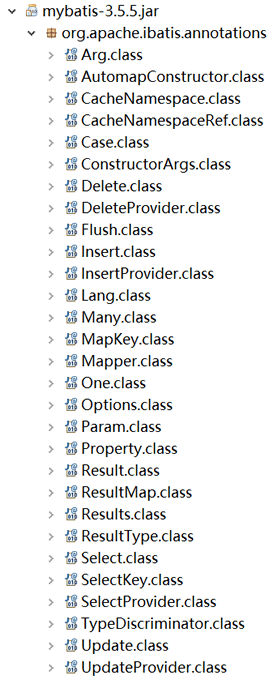为了简化 XML 的配置,MyBatis 提供了注解。我们可以通过 MyBatis 的 jar 包查看注解,如下图所示。

以上注解主要分为三大类,即 SQL 语句映射、结果集映射和关系映射。下面分别进行讲解。
1. SQL 语句映射
1)@Insert:实现新增功能
- @Insert("insert into user(id,name) values(#{id},#{name})")
- public int insert(User user);
2)@Select:实现查询功能
- @Select("Select * from user")
- @Results({
- @Result(id = true, column = "id", property = "id"),
- @Result(column = "name", property = "name"),
- @Result(column = "sex", property = "sex"),
- @Result(column = "age", property = "age")
- })
- List<User> queryAllUser();
3)@SelectKey:插入后,获取id的值
以 MySQL 为例,MySQL 在插入一条数据后,使用 select last_insert_id() 可以获取到自增 id 的值。
- @Insert("insert into user(id,name) values(#{id},#{name})")
- @SelectKey(statement = "select last_insert_id()", keyProperty = "id", keyColumn = "id", resultType = int,before = false)
- public int insert(User user);
@SelectKey 各个属性含义如下。
- statement:表示要运行的 SQL 语句;
- keyProperty:可选项,表示将查询结果赋值给代码中的哪个对象;
- keyColumn:可选项,表示将查询结果赋值给数据表中的哪一列;
- resultType:指定 SQL 语句的返回值;
- before:默认值为 true,在执行插入语句之前,执行 select last_insert_id()。值为 flase,则在执行插入语句之后,执行 select last_insert_id()。
4)@Insert:实现插入功能
5)@Update:实现更新功能
6)@Delete:实现删除功能
7)@Param:映射多个参数
@Param 用于在 Mapper 接口中映射多个参数。
@Param 中的 value 属性可省略,用于指定参数的别名。
2. 结果集映射
@Result、@Results、@ResultMap 是结果集映射的三大注解。
声明结果集映射关系代码:
- @Select({"select id, name, class_id from student"})
- @Results(id="studentMap", value={
- @Result(column="id", property="id", jdbcType=JdbcType.INTEGER, id=true),
- @Result(column="name", property="name", jdbcType=JdbcType.VARCHAR),
- @Result(column="class_id ", property="classId", jdbcType=JdbcType.INTEGER)
- })
- List<Student> selectAll();
下面为 @Results 各个属性的含义。
- id:表示当前结果集声明的唯一标识;
- value:表示结果集映射关系;
- @Result:代表一个字段的映射关系。其中,column 指定数据库字段的名称,property 指定实体类属性的名称,jdbcType 数据库字段类型,id 为 true 表示主键,默认 false。
可使用 @ResultMap 来引用映射结果集,其中 value 可省略。
- @Select({"select id, name, class_id from student where id = #{id}"})
- @ResultMap(value="studentMap")
- Student selectById(Integer id);
这样不需要每次声明结果集映射时都复制冗余代码,简化开发,提高了代码的复用性。
3. 关系映射
1)@one:用于一对一关系映射
- @Select("select * from student")
- @Results({
- @Result(id=true,property="id",column="id"),
- @Result(property="name",column="name"),
- @Result(property="age",column="age"),
- @Result(property="address",column="address_id",one=@One(select="net.biancheng.mapper.AddressMapper.getAddress"))
- })
- public List<Student> getAllStudents();
2)@many:用于一对多关系映射
纯文本复制- @Select("select * from t_class where id=#{id}")
- @Results({
- @Result(id=true,column="id",property="id"),
- @Result(column="class_name",property="className"),
- @Result(property="students", column="id", many=@Many(select="net.biancheng.mapper.StudentMapper.getStudentsByClassId"))
- })
- public Class getClass(int id);
郑重声明:本文版权归原作者所有,转载文章仅为传播更多信息之目的,如作者信息标记有误,请第一时间联系我们修改或删除,多谢。
本文链接:https://www.jhelp.net/p/J4nfvGRp8748fz4b (转载请保留)。
关注下面的标签,发现更多相似文章
本站推荐
-
1086
-
1085
-
1009
-
1000
-
995
文章目录
